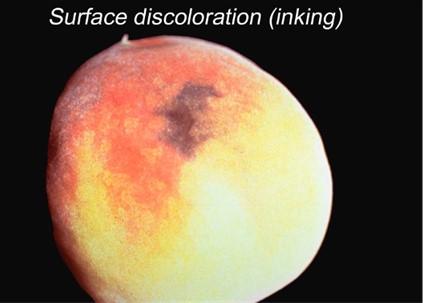Inking in Peaches and Nectarines: Symptoms, Causes and Control
Symptoms of Peach and Nectarine Inking:
Field inking or skin discoloration is characterized by the appearance of dark colored, brown-black spots or longitudinal stripes on the fruit surface, restricted to the skin (Fig. 1). Inking affects the skin cells and causes the death of these cells, but it will not affect the tissue below or the flesh of the fruit. Although the symptoms are superficial and cosmetic, they render the fruit unmarketable or cause them to be second grade. Inking symptoms can be triggered in the field, during harvest as well as during transportation to the packinghouse. The symptoms do not become visible immediately (inking can become evident after 48 hours after harvest). Peaches are more susceptible than nectarines, but the susceptibility to inking can also vary depending on the cultivar, as well as environmental conditions and the management strategies used in the orchard.
Causes of Peach and Nectarine Inking:
Abrasion damage in combination of heavy metals such as aluminum, copper or iron can cause the development of peach and nectarine fruit inking. These metals may come from water or applied products such as fungicides, insecticides, or foliar fertilizers, which can have the ability to induce field inking on peach and nectarine when followed by abrasion damage. The inking results from the collapse of the skin cells, which contain the anthocyanin and phenolic pigments important for color development, and thus their contents react with the heavy metals turning their color black/brown. Research in California has shown that only 10 ppm of iron (Fe) is enough to induce peach and nectarine inking. Wash water high in iron or low in pH can also increase the inking problems. Additionally, excess rain at harvest, very common in the mid-Atlantic, can cause fruit swelling and cell damage together with storm damage and abrasion. This situation, in combination with the presence of heavy metals, can increase the incidence of inking.
Steps to avoid Peach and Nectarine Inking:
There are several measures that can be taken in order to control the development of field inking. Some of these include: handling fruit gently in order to avoid abrasion damage (prefer using air-ride suspension on trailers and avoid long hauling); avoiding and reducing fruit contamination by keeping containers dirt, dust free and clean; picking fruit in the morning instead of later during the day; near harvest choose chemical applications carefully and avoid spraying foliar nutrients or preharvest fungicides containing aluminum, copper or iron within 3 weeks of anticipated harvest; check your water quality for contamination with heavy metals (water with acidic characteristics (< 6.5) can exacerbate inking due to increased iron availability); test your fungicides for presence of heavy metals early in the season (be aware of the composition of the chemicals you use in your preharvest and postharvest operations); delaying packing for ~48 hours can allow to remove fruit with inking symptoms during grading (as the symptoms do not develop immediately).
This article appears in the June 2022, Volume 13, Issue 3 of the Vegetable and Fruit News
